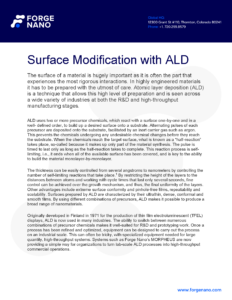RF & POWER ELECTRONICS

Atomic Layer Deposition for Encapsulation and Hermetic Sealing of RF and Power Electronics
Radio frequency (RF) and power electronics are vital to an array of industries, from telecom and consumer electronics to transportation and energy distribution. As energy diversification and the prevalence of high-speed electronics continue to grow, RF and power electronics are expected to reach a global market of $36.6 billion by 2027.1 Extreme environments such as high temperatures, ultra-violet radiation, oxygen, salinity and moisture are all threats that degrade and corrode active components causing early failure. Atomic layer deposition (ALD) has created substantial improvements to the reliability and performance of RF and power electronics. Using ALD as an encapsulation layer at the wafer level or as a final hermetic seal at the chip/module/PCB level has been shown to substantially improve electronic performance and lifetime.2,3 ALD layers enable longer lifetimes, higher performance and lower cost without adding the considerable mass gain and high temperature processing associated with conventional hermetic coatings.
ALD Improves RF and Power Electronics
The benefits of ALD layers:
- Hermetic sealing encapsulation layers with minimal thickness
- Pristine conformality in high-aspect ratio structures
- Ultra-low particle generation
- Low stress films
- Improved lifetime of ICs and PCBs
- Increased resistance to harsh environments
- No peeling or flaking of the hermetic seal at pressures >1200 PSI
- Negligible mass gain from coating at 100 nm
There are two major methods of using ALD in RF and power electronics:
1. Overcoat encapsulation layer at the wafer level
2. Hermetic sealing at the package level
ALD at the Wafer Level
One of the most important layers in post-gate processing for RF and power devices is the encapsulation layer to protect the device from environmental degradation. Thin encapsulation layers have found to decrease humidity permeation rates on moisture sensitive devices.4 In a study from April 2020, RF microelectronic mechanical devices (MEMs) were encapsulated with SiNx thin films for environmental protection on 5G devices and showed successful mechanical protection.5 Beyond environmental protection, encapsulation layers have also been found to improve RF device performance. One study showed encapsulated GaAs-based terahertz emitters increased the average power output fourfold by enhancing the conductivity and prevention oxidation at the semiconductor surface.6
Plasma enhanced chemical vapor deposition (PECVD) has historically been used for encapsulation deposition, however, the use of plasma damages delicate semiconductor surface states with energetic ions, chemical radicals and UV radiation. Presence of these surface states gives rise to hopping conduction, which lowers the breakdown voltage of the gate. The thermal nature of ALD does not require damaging plasma or high energy ions for deposition and helps maintain delicate surface electronic states and increases reliability of the circuit.2 ALD provides an electrically-low- leakage film, with no pinholes and a high dielectric constant at deposition temperatures down to 80oC. With these improvements in film quality, ALD has largely started to displace PECVD in post- gate processing as deposition rates have increased.10 Common ALD chemistries for this application, such as Si3N4, Al2O3, HfO2, TiO2 and ZnO can be deposited by ALD using commercial precursors commonly used for PECVD/CVD processes.2
Compared to other deposition techniques, ALD provides a hermetic seal which provides greater device protection. Sputtering, physical vapor deposition (PVD) and CVD provide imperfect coatings where pinhole defects are common. These pinhole defects provide point locations for corrosion to enter the device leading to early failure.7 The low-stress and pinhole-free ALD films provide a vital protective barrier over the active device. Active devices will fail if moisture finds a path to the ohmic contacts, channels of field effect transistors (FETs) or junctions of heterojunction bipolar transistors (HBTs). However, these active devices are well-protected from moisture with ALD films. In one study, SiN ALD encapsulated FETs were compared with PECVD encapsulated FETs under an accelerated stress test, 130oC and 85% relative humidity, the PECVD coated FETs had a 99% failure rate compared to 2.7% for ALD coated FETs, predicting reliable ALD performance under worst-case conditions for MMICs.8 GaAs Process | Coatings | Bias | Failures |
0.50 um Optical FETs | SiN | 11V | 99% |
0.50 um Optical FETs | ALD-Cap | 11V | 2.7% |
0.50 um E-Beam FETs | ALD-Cap | 7V | 0.3% |
Table 1: A 96 hour Highly Accelerated Stress Test (HAST) at 130oC and 85% relative humidity was used as a benchmark for the optimization of the ALD layers. The devices are biased at pinchoff during the test which is the maximum stress condition. The ALD FETs had a much lower failure rate than the original SiN FETs.8
ALD Encapsulation at the Package Level
Due to application challenges in extreme environments, RF and power electronics require robust hermetic sealing to maintain reliability over conventional integrated circuits. Electronics demanding this extra layer of protection frequently use plastic to encapsulate circuits for added protection which creates additional weight and cost to the final product.7 In certain aerospace applications requiring military standards (MIL-STD), ceramic encapsulation provides more protection than plastic packaging yet requires higher temperature processing and adds significant weight to the final product.
ALD provides the best of both fabrication methods by using ceramic coatings to create a hermetic seal while maintaining low deposition temperatures (down to 70°C in some cases), lower costs than traditional plastic hermetic packaging and a negligible mass gain to the final product.8,11 Using ALD at ~200nm thicknesses has shown more efficient hermetic seals with higher performance and lower temperature processing.11 In a recent study, 100nm ALD deposited films of SiO2/HfO2 onto RF chiplets showed no degradation after 100 days at 87oC in a saline environment during accelerated aging testing.12
At the printed circuit board (PCB) level, environmental factors can introduce failure modes when not protected with hermetic seals. Tin whiskers, thin electrically conducting structures that form on PCB assemblies, can grow up to 10mm long to create electrical shorts on different board components. Using ALD as thin as 10nm on PCB assemblies saw a significant decrease in tin whiskers, dramatically extending the lifetime of the product.13
Figure 1: FIB-cut SEM image showing SiO2/TiO2 ALD laminated layers on a circuit card assembly with a 250 nm thickness.11
About Forge Nano
Forge Nano is a leading materials science company harnessing the power of Atomic Armor, the company’s proprietary ALD nanocoating technology, to accelerate manufacturing innovation, transform product performance and achieve a more sustainable future for a range of industries around the world. Atomic Armor produces superior coatings that can unlock a material’s performance at the atomic level and deliver custom solutions from small-scale R&D and laboratory work to large-scale, high-volume production lines. A range of materials can be enhanced through Atomic Armor, including batteries, medical devices, catalysts, propellants and 3D additives. Forge Nano has received major support and signed meaningful partnerships with Volkswagen, LG Technology Ventures, Mitsui Kinzoku, Air Liquide and Sumitomo Corporation of Americas, largely as a result of the company’s innovation in the Lithium-ion battery industry and successful track record of improving product performance and safety while reducing cost.
Forge Nano’s Capabilities
- >20 in-house ALD systems for coating of wafers, powders and objects
- Including research, pilot and commercial scale systems capable of processing anywhere from 1.0 g to 30,000 kg powder or extrudates per day
- Fast deposition times up to 30nm per minute for rapid Al2O3 ALD coating solutions
- The world’s most knowledgeable and experienced team for ALD onto a range of materials
- PhD scientists, certified Professional Engineers, career scientists
- 20+ years’ experience designing and building powder ALD systems
Working with Forge Nano
Forge Nano assists customers daily with both R&D and commercialization of ALD-enabled materials. For R&D, we offer research services for proofs of concept and also sell our R&D equipment globally. For commercialization, we offer joint development of products, production equipment and IP licensing.
References
1. “Power Electronics Market Size, Latest Trend & Competitive Statistics 2027.” Allied Market Research, June 2020, www.alliedmarketresearch.com/power-electronics-market.
2. “Section 16.3.” III-V Integrated Circuit Fabrication Technology, by Shiban Kishan Tiku and Dhrubes Biswas, Pan Stanford Publishing, 2016.
3. A. Leuther, M. Ohlrogge, L. Czornomaz, T. Merkle, F. Bernhardt and A. Tessmann, “A 250 GHz millimeter wave amplifier MMIC based on 30 nm metamorphic InGaAs MOSFET technology,” 2017 12th European Microwave Integrated Circuits Conference (EuMIC), Nuremberg, 2017, pp. 130-133, doi: 10.23919/EuMIC.2017.8230677.
4. Ferdinandus J.H. van Assche, Sandeep Unnikrishnan, Jasper J. Michels, Antonius M.B. van Mol, Peter van de Weijer, Mauritius C.M. van de Sanden, Mariadriana Creatore, On the intrinsic moisture permeation rate of remote microwave plasma-deposited silicon nitride layers, Thin Solid Films, Volume 558, 2014, Pages 54-61, ISSN 0040-6090
5. A. Persano, F. Quaranta, A. Taurino, P. A. Siciliano, and J. Iannacci, “Thin Film Encapsulation for RF MEMS in 5G and Modern Telecommunication Systems,” Sensors (Basel, Switzerland), vol. 20, no. 7, p. , Apr. 2020.
6. C. Headley et al., “Improved Performance of GaAs-Based Terahertz Emitters via Surface Passivation and Silicon Nitride Encapsulation,” in IEEE Journal of Selected Topics in Quantum Electronics, vol. 17, no. 1, pp. 17-21, Jan.-Feb. 2011, doi: 10.1109/JSTQE.2010.2047006.
7. Kääriäinen Tommi, et al. Atomic Layer Deposition: Principles, Characteristics, and Nanotechnology Applications. Wiley-Scrivener, 2013.
8. “Atomic Layer Deposition (ALD) Environmental Coatings for GaAs MMICs.” Sundewtech.com, Raytheon / Sundew Tech, 2013, sundewtech.com/wp-content/uploads/2020/10/CS-Mantech_2013_02R-Environmental-Protection-through-ALD.pdf.
9. Yota, Jiro, et al. “Characterization of Atomic Layer Deposition HfO2, Al2O3, and Plasma-Enhanced Chemical Vapor Deposition Si3N4 as Metal–Insulator–Metal Capacitor Dielectric for GaAs HBT Technology.” AVS, American Vacuum SocietyAVS, 1 Nov. 2012, avs.scitation.org/doi/abs/10.1116/1.4769207.
10. “PEM-INST-001: Instructions for Plastic Encapsulated Microcircuit (PEM) Selection, Screening, and Qualification.” NASA Technical Reports Server (NTRS), NASA, 2003, ntrs.nasa.gov/citations/20040082092.
11. “MMIC Coatings and Encapsulation for Non-Hermetic, Low Cost, Transmit/Receive Modules with the Reliability of Hermetic Packaging.” MMIC Coatings and Encapsulation for Non-Hermetic, Low Cost, Transmit/Receive Modules with the Reliability of Hermetic Packaging | SBIR.gov, www.sbir.gov/sbirsearch/detail/319997.
12. Jeong, Joonsoo, et al. “Conformal Hermetic Sealing of Wireless Microelectronic Implantable Chiplets by Multilayered Atomic Layer Deposition (ALD).” Advanced Functional Materials, 2018, p. 1806440., doi:10.1002/adfm.201806440.
13. E. Chason, N. Jadhav, et al. “Atomic Layer Deposition (ALD) to Mitigate Tin Whisker Growth and Corrosion Issues on Printed Circuit Board Assemblies.” Journal of Electronic Materials, Springer US, 1 Jan. 1970, link.springer.com/article/10.1007/s11664 -019-07534-7.
14. “Sundew Technologies – ALD Cap Exceptional Barrier Performance.” Sundew Technologies, sundewtech.com/wp- content/uploads/2020/09/ALD-CAP.pdf

